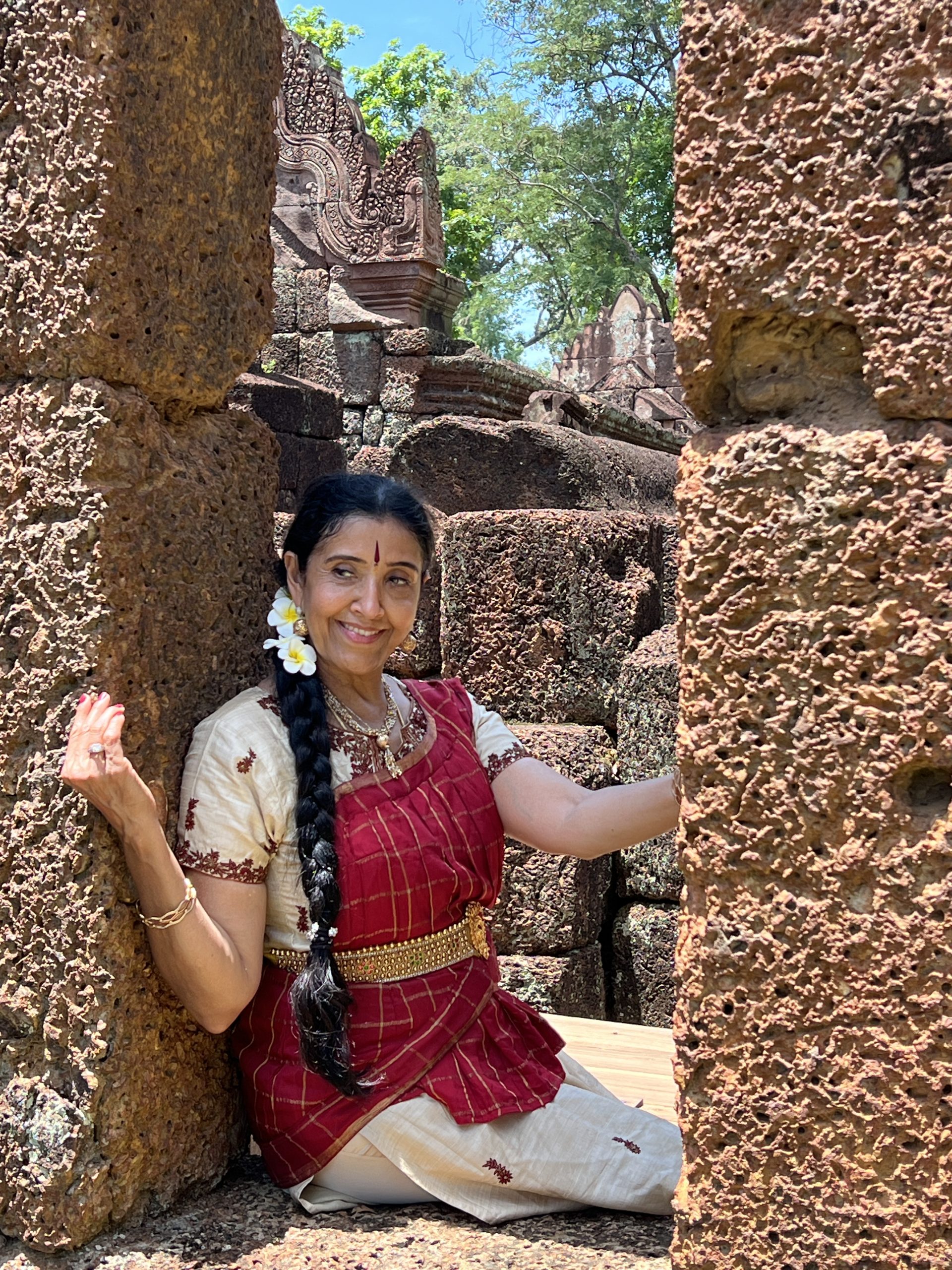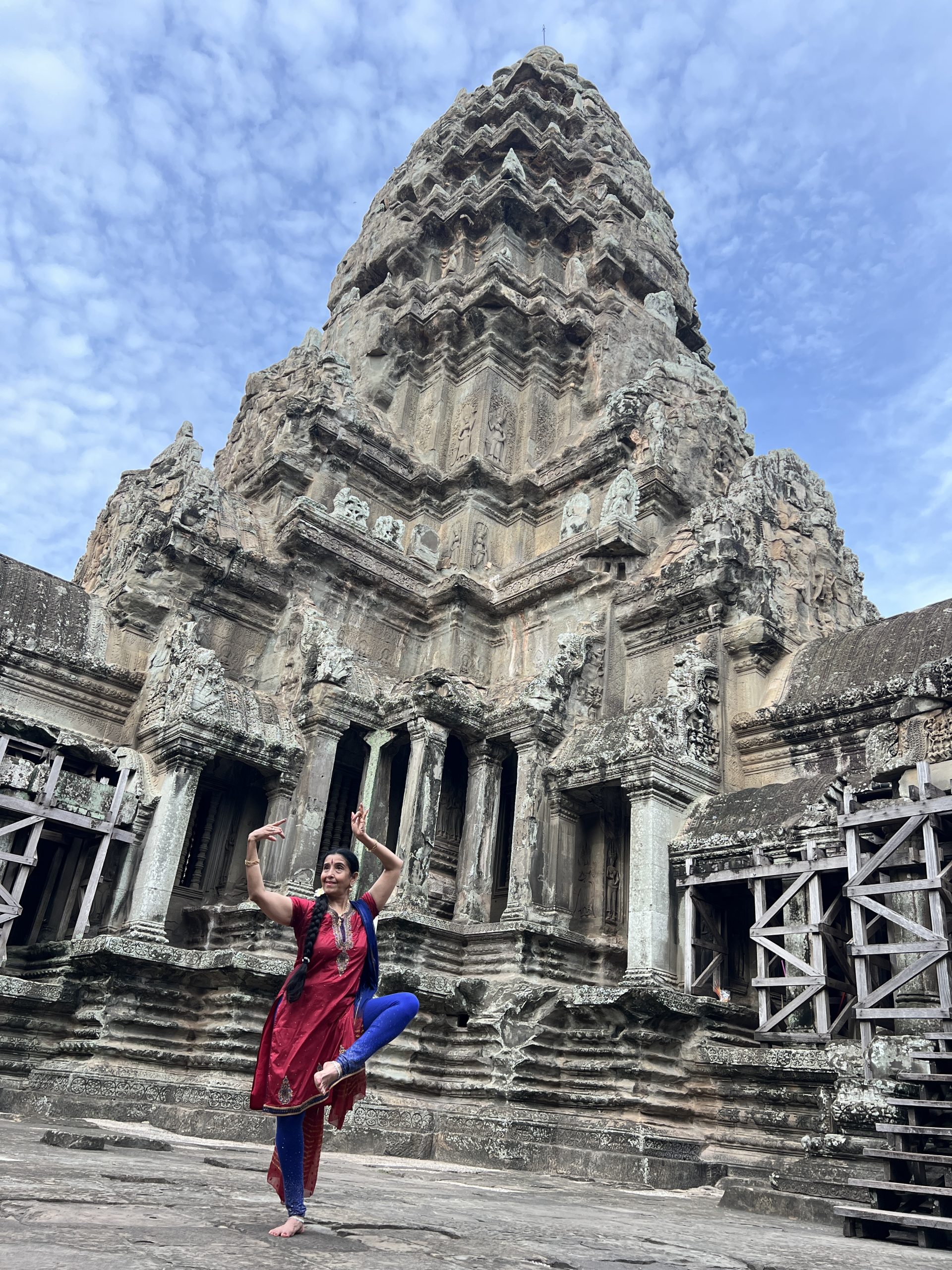She’s speaking the universal language.
By Aiden Jewelle Gonzales
Before the advent of Artificial Intelligence (AI), when it was still relegated to the realm of science-fiction, I’d always thought that the arts would be the last bastion against AI-generated content. After all, as famously questioned in the movie, I, Robot (2004), “Can a robot write a symphony?” Now, with the exponential integration of AI into everyday life, the answer is, of course, yes. However, what is perhaps the more relevant question is, how can we in the creative fields still perform or generate content that resonates with other humans, beyond just the technically-brilliant but arguably-soulless, copy-and-paste creations by technology? Bala Devi Chandrashekar, a Bharatanatyam exponent and research scholar who’s studied the ancient art from Bharatanatyam for decades, answered this question beautifully in our exclusive interview with her.
“Bharatanatyam, as an art form itself, is like a flowing river,” she tells me in what I soon discover is her characteristic eloquence and lyricism. “It has literary, music and art history value, and much more. While you can learn the technique, Marga, and adapt it to the desi styles, it is the intuitive intelligence and maturity of the artist that allows you to speak a universal language to people from every caste, creed, race, and religion. The presentationshould adhere to tradition and be vivid for even the most uninitiated audience connect to it.” It is the command of the artist, she tells me, that will allow even ancient art forms to have a spotlight on the global stage. “You need not sacrifice tradition, but you can still answer to the current audience, because art like Bharatanatyam will stand the test of time,” she tells me, impassioned.
Hailing from Thanjavur, which Bala Devi refers to as the “seat of dance and music,” she started her dance journey from the age of five, in Hyderabad, and went on to learn from her legendary guru, Dr. Padma Subrahmanyam in Chennai, who she acknowledges has been a great source of inspiration for all her productions. Since her 20s, she was always interested in bridging the gap between theory and practice, and has been performing alongside a corporate job for many years. She mentioned that there are literary scholars in her family, which also encouraged her to pursue dance: “My great grandfather was a Sanskrit guru, my uncle was also a Sanskrit scholar, so the whole family encouraged me to pursue dance as a way of delving into these texts. After my marriage, I joined an encouraging family who were adept in ancient Indian literature and the Vedic texts. For the last 15-20 years, I’ve focused solely on dance, making it my life’s work to travel on this wondrous path of taking these universal messages across the globe.”
Since then, she’s become a globally-renowned artistic director of the New Jersey Bharatanatyam Academy SPNAPA; an Artist-in-Residence in Ivy League universities such as Princeton University, and given lectures in Columbia University and the University of Pennsylvania; and performed in over 30 countries in front of dignitaries from around the world, including at a UNESCO World Heritage site, in Broadway as a solo performer, and the FBI. “The key here is the confidence to perform anywhere, and to never compromise on the technique or the form of Bharatanatyam, because it’s a traditional art form,” she says. “I have done shows where I play 40 characters, during which an artist needs to have an in-depth study of the texts,” she reveals. “It’s very engaging because it’s almost like a movie, especially keeping in mind the technical aspect and the heavy emphasis on a universal message.”
Recently, she’s just ended a month-long performance tour of the Far East and Southeast Asia, including Thailand, during which she embarked on “a journey through time” and “sought to unravel the intricate threads that connect our dance forms across generations.” She spoke to us further about her tour and the transformative power of Bharatanatyam to strengthen cultural and community ties.
You’ve had the opportunity to perform on prestigious stages worldwide, including a UNESCO World Heritage site. Could you tell us about one of your most memorable performances and the significance of the location?
During my recent tour, the reception I had in Southeast Asia was incredible because I could feel that the soul of SE Asia was so intertwined with India. Throughout my tour, which included performances, lectures, and workshops in over seven countries, I have gained a unique perspective on the importance of creating a cultural corridor through which we can better appreciate and understand each other’s cultures. My tour helped me find the similarities that bind us together, and a newfound appreciation for the diversity and uniqueness of our respective dance forms.
Meanwhile, my performance of the Thanjavur “Brihadeesvara – Form to formless” a 1,000-year-old UNESCO World Heritage site, was presented at the UNESCO headquarters in Paris to an audience of 600 people, over 150 of which were ambassadors and diplomats. It was an incredible experience and close to my heart since I belong to Thanjavur.
With over three decades of experience in over 30 countries, how has the global understanding and appreciation of Indian dance changed over the years?
Bharatanatyam was a temple ritual. Today there is more recognition of it as an art form, but a lot more needs to be done to put it on the world map. I have lofty ideals to take it to the best platforms on the international stage, and I have – I’ve taken it to theMetropolitan Museum of Art, UNESCO, the FBI, and Broadway, and I will continue to stage them in more prestigious venues across the globe.
I see myself as a soft power ambassador in creating lasting cultural ties. Many have said that they have had a transformative experience after watching my performances, and I think it’s because in the day and age when there is so much more importance placed on mental and physical health, Bharatanatyam provides an anchor for that. It’s the ultimate form of yoga, where everyone can have an aesthetic experience.
As a dance researcher, how do you balance preserving traditional elements of Indian dance with incorporating contemporary aspects to keep the art form relevant to diverse and modern audiences?
I firmly believe Bharatanatyam will stand the test of time. And once you have that conviction, you don’t have to dilute it to attract modern audiences. This demands that you become a holistic artist that answers the call of every audience across the globe, with knowledge of language, drama, rhythm, presentation, and the dance itself. At the end of the day, even for modern audiences, the history, artefacts, rituals, and architecture, all stand tall by themselves. I never compromise just to suit my audience. And in fact, that uncompromising attitude is very evocative for people from varied places in the USA, Europe, South America, Middle East and Southeast Asia. I find people who want to be connected to the art form and tradition.
You said you see yourself as a cultural ambassador. Can you tell us a little about how you’ve fostered cross-cultural exchange and understanding in your visit to Thailand in particular?
Thai dance is very similar to Khmer dance. There are a lot of movements that are all derived from the Natya Shastra, so when I watch Thai dance performances, I can immediately connect it to the ancient texts. There are a lot of similarities that I see, whether it is the movement itself, or the concept from some ancient texts like the Ramayana or Mahabharata. I see a lot of similarity, and I’m even planning to collaborate with some of those artists.
Can you expand a little more on these artistic collaborations?
I have connected in the past with dance artists in jazz, modern dance, ballet and more. The theatre wing of Princeton University, McCarter Theatre even invited me as a movement consultant for two of their productions – Arabian Nights and Mad 7 based on Hebrew literature. Dance being a universal language, it was interesting to adapt for other world traditions.
Indian dance is deeply connected to spirituality. How has your dance journey helped you evolve spiritually, and can you share a performance or choreography where you felt a deep connection to the story you were expressing?
To me, every text that I have performed has touched me very deeply. One particular text guides my life, and that is in The Uddhava Gita when Lord Krishna talks about the 24 gurus that we can find in nature. I believe in divinity in whomever we interact. I have a done a programme called the Festival of Faiths in Princeton University, during which I represented Hinduism, and we had other artists representing Sufism, Judaism, and more. While we represented different faiths, we all represented the same spiritual energy. It’s beyond scientific or objective subjects. Dance always brings positive energy.
Have you encountered any misconceptions or stereotypes about Indian dance during your performances abroad? How do you address such misconceptions, and where do you see the future of Indian dance on the global stage?
Sometimes I feel that just to entice a totally non-Eastern crowd, professors or performers can misinterpret a text and there’s no need to do that. I always represent the text in the authentic form, and I try to always clarify those points and go out of my way to provide the information to the audience. I’m a stickler for tradition and perfection, and I hope that as Indian dance gains more of a spotlight on the global stage, people will understand and appreciate it.








